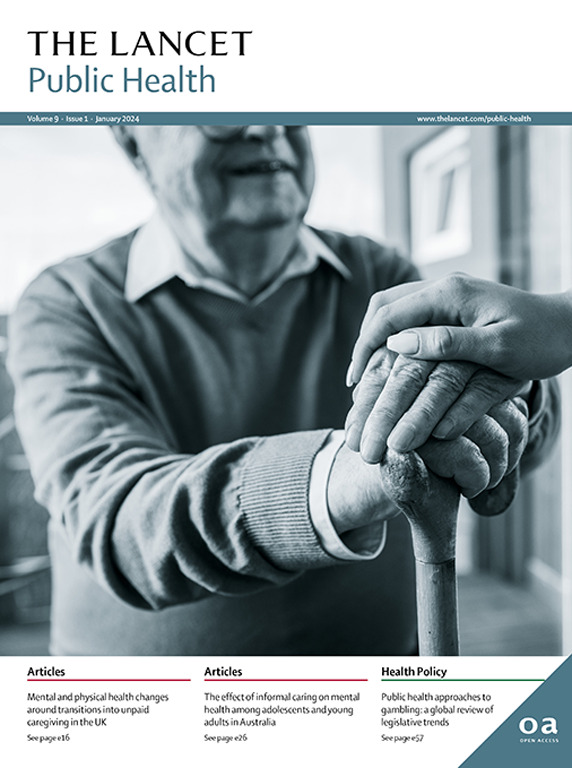评估美国县卫生保健系统绩效和关键相关因素(2014-19):三重目标框架分析
IF 25.2
1区 医学
Q1 PUBLIC, ENVIRONMENTAL & OCCUPATIONAL HEALTH
引用次数: 0
摘要
卫生保健的三重目标——定义为同时追求积极的患者体验、积极的健康结果和低支出——已被确立为卫生保健系统的目标。与其他国家相比,美国卫生保健系统的卫生支出率高,健康结果差,尽管在美国各州和县一级都存在很大差异。评估美国哪些县在实现“三重目标”方面最成功,哪些实施的政策与高绩效相关,对于制定改善全国医疗保健的政策可能很有价值。在这项研究中,我们的目标是量化在美国县一级实现“三重目标”的进展。方法采用生态分析方法,结合2014 - 2019年“三重目标”各组成部分的县级数据,评估卫生保健系统的绩效。通过综合指标评估患者体验,通过预期寿命评估健康结果,通过人均购买力调整后的医疗保健支出评估低支出。对于每个国家,总体未调整的表现分数是根据三个目标的数据生成的。然后计算调整后的绩效分数,控制了卫生系统控制之外的关键县特征。使用线性回归来评估哪些政策相关因素与表现最佳的县相关。研究发现,与得分较低的县相比,未调整绩效得分较高的县往往拥有更高的受教育程度、更富裕的人口,城市居民比例较高,肥胖率和吸烟率较低。在调整了这些基本特征的县得分后,罗德岛州、爱荷华州、爱达荷州、弗吉尼亚州和夏威夷州的县在实现“三重目标”方面处于领先地位,而哥伦比亚特区、阿拉斯加州、特拉华州、密西西比州和俄克拉荷马州的得分最低。在政策相关因素方面,实现“三重目标”的进展与管理式医疗的优先次序、扩大医疗补助覆盖范围以及竞争激烈的医院和保险市场有关。这些发现突出了与卫生保健系统绩效相关的卫生系统差异和政策。这些结果可帮助决策者制定战略,减少卫生保健支出,增加获得保健的机会和提高保健质量,并最终改善健康结果。彼得森医疗保健中心和盖茨风险投资公司。本文章由计算机程序翻译,如有差异,请以英文原文为准。
Evaluating US county health-care system performance and key associated factors (2014–19): a Triple Aim framework analysis
Background
The Triple Aim of health care—defined as the simultaneous pursuit of positive patient experience, positive health outcomes, and low spending—has been established as a goal for health-care systems. The US health-care system has high rates of health spending and poor health outcomes relative to other countries, although there is substantial variation within the country at both state and county level. Assessing which US counties have been most successful in achieving the Triple Aim, and which implemented policies are associated with high performance, could be valuable for developing policies that improve health care nationwide. In this study, we aimed to quantify progress towards the Triple Aim at the US county level.Methods
In this ecological analysis, county-level data on each component of the Triple Aim were combined to assess health-care system performance from 2014 to 2019. Patient experience was assessed via a composite indicator, health outcomes via life expectancy, and low spending via purchasing power-adjusted health-care expenditure per capita. For each county, overall unadjusted performance scores were generated from data on each of the three aims. Adjusted performance scores were then calculated that controlled for key county characteristics outside of the control of the health system. Linear regression was used to assess which policy-relevant factors were associated with the best-performing counties.Findings
Counties with higher unadjusted performance scores tended to have populations that were more educated, wealthier, had a higher proportion of residents in urban households, lower rates of obesity, and lower rates of smoking than counties with lower scores. After adjusting county scores for these underlying characteristics, counties in Rhode Island, Iowa, Idaho, Virginia, and Hawaii led in progress towards the Triple Aim, whereas the District of Columbia, Alaska, Delaware, Mississippi, and Oklahoma had the lowest scores. Regarding policy-relevant factors, progress towards the Triple Aim was associated with a prioritisation of managed care, expanded Medicaid coverage, and competitive hospital and insurance markets.Interpretation
These findings highlight health system disparities and policies that were associated with health-care system performance. These results can help policy makers to develop strategies that reduce health-care spending, increase access to and quality of care, and ultimately improve health outcomes.Funding
Peterson Center on Healthcare and Gates Ventures.求助全文
通过发布文献求助,成功后即可免费获取论文全文。
去求助
来源期刊

Lancet Public Health
Medicine-Public Health, Environmental and Occupational Health
CiteScore
55.60
自引率
0.80%
发文量
305
审稿时长
8 weeks
期刊介绍:
The Lancet Public Health is committed to tackling the most pressing issues across all aspects of public health. We have a strong commitment to using science to improve health equity and social justice. In line with the values and vision of The Lancet, we take a broad and inclusive approach to public health and are interested in interdisciplinary research.
We publish a range of content types that can advance public health policies and outcomes. These include Articles, Review, Comment, and Correspondence. Learn more about the types of papers we publish.
 求助内容:
求助内容: 应助结果提醒方式:
应助结果提醒方式:


